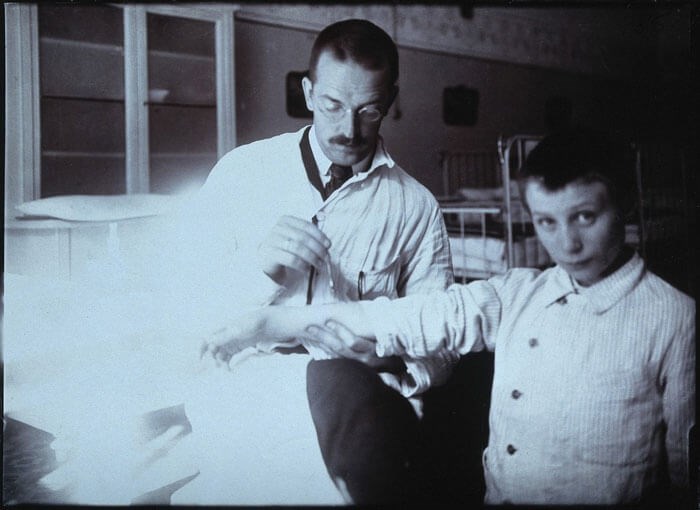Allergy is defined as an “abnormal immune reaction to an ordinarily harmless substance” [1], however the meaning of the word has taken many forms since its introduction in 1906 by Austrian Paediatrician and Immunologist, Clemens von Pirquet [2]. Combining his observations on the paediatric wards, where infectious diseases, vaccinations and diphtheria serum sickness were commonplace, and his knowledge of immune reactions in the laboratory, von Pirquet devised the term ‘allergy’, roughly translating as ‘different reaction’ in Greek.
It grouped together illnesses such as asthma, hay fever and eczema, and placed them on the same spectrum as acquired immunity from vaccinations and reactions to therapeutic toxins. His conclusions were extrapolated by Charles Mantoux to develop his tuberculin test two years later.

Clemens von Pirquet with a patient. Image courtesy of Wellcome Collection
- https://wellcomecollection.org/works/yd78ffbn
Unfortunately, this theory linking immunity and hypersensitivity, and von Piquet’s subsequent inference that antibodies could be both protective and harmful, was dismissed by many of his peers, who instead supported French Physiologist, Charles Richet. Richet’s work on reinjection of dogs with sea anemone toxins showed that a small, second dose could induce a significant, even fatal reaction. He supposed this pathology to be caused by the toxin, rather than the host reaction, naming it ‘anaphylaxis’ – a deficiency of immunity, quite opposite to von Pirquet’s hypothesis – and was awarded the 1913 Nobel Prize. This was not the first Nobel laureate that von Pirquet clashed with; earlier in his career he had previously challenged an aspect of Paul Ehrlich’s side-chain theory of cell receptors that bound and neutralised toxins, claiming that his neutralisation calculations were incorrect (Ehrlich went on to win the 1908 Nobel Prize for this and other work in the field of immunology, although von Pirquet was subsequently proved correct).
However, by the 1920s, von Pirquet’s conceptual framework was gaining traction, as was the rise of allergy as a modern, Western, affluent and even fashionable condition. This coincided with an expansion of medicine’s focus from mortality to also include morbidity – as governments realised the economic cost of chronic illness. Allergy became a clinical specialty in its own right, with dedicated clinics, journals and professional organisations in the interwar years. Pharmaceutical investment followed, targeting histamine and trials of desensitisation therapies.
The meaning of ‘allergy’ was narrowed over time into what we recognise as today’s definition, but modelling allergy as a continuation of protective immunity was reinforced by the hypersensitivity classification published by R Coombs and P Gell in the 1960s [3]. This was further bolstered by evidence of Immunoglobulin E’s role in helminth immune reactions [4]. That the Gell and Coombs classification is still used today – albeit in a modified version – is a testament to von Pirquet’s insight. Sadly, despite his professional achievements, he had an unhappy personal life, alienated by both colleagues and family, whilst struggling with his wife’s chronic illnesses against a backdrop of fractious politics in his home country. The von Pirquets took their lives in an apparent suicide pact in 1929, ingesting potassium cyanide.
References
1. AAAAI. The American Academy of Allergy, Asthma & Immunology.
www.aaaai.org/conditions-and-treatments/
conditions-dictionary/allergy
Last accessed October 2020.
2. Jackson M. Allergy, The History of a Modern Malady. London, UK; Reaktion Books; 2006.
3. Pamphilon DH, Scott ML. Robin Coombs: His Life and Contribution to Haematology and Transfusion Medicine. British Journal of Haematology 2007;137(5):401-8.
Amoah AS, Boakye DA, Yazdanbakhsh M, van Ree D. Influence of Parasitic Worm Infections on Allergy Diagnosis in Sub-Saharan Africa Current Allergy and Asthma Reports 2017;17(65).




